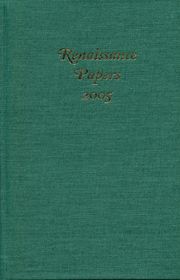Book contents
- Frontmatter
- Contents
- Renaissance Papers
- Bronzino, Castiglione, and A Self-Portrait: Re-evaluating Bronzino's Trip to Pesaro
- Tracing Astrophil's “Coltish Gyres”: Sidney and the Horses of Desire
- Shakespeare's Twins: Choric Juxtaposition
- Rhetoric and Intimacy in The Tempest
- “That Holy roome”: John Donne and the Conduct of Worship at St. Paul's Cathedral
- Conversation in Hutchinson's Order and Disorder and Milton's Paradise Lost
- Dryden on Epicoene's “Malicious Pleasure”: The Case of the Otters
“That Holy roome”: John Donne and the Conduct of Worship at St. Paul's Cathedral
Published online by Cambridge University Press: 12 September 2012
- Frontmatter
- Contents
- Renaissance Papers
- Bronzino, Castiglione, and A Self-Portrait: Re-evaluating Bronzino's Trip to Pesaro
- Tracing Astrophil's “Coltish Gyres”: Sidney and the Horses of Desire
- Shakespeare's Twins: Choric Juxtaposition
- Rhetoric and Intimacy in The Tempest
- “That Holy roome”: John Donne and the Conduct of Worship at St. Paul's Cathedral
- Conversation in Hutchinson's Order and Disorder and Milton's Paradise Lost
- Dryden on Epicoene's “Malicious Pleasure”: The Case of the Otters
Summary
IN his poem “Hymn to God My God in my Sicknesse,” John Donne uses imagery drawn from the realm of the performing arts to articulate the claim that illness can both bring one closer to God and also help one prepare for that encounter. His speaker notes:
SINCE I am comming to that Holy roome,
Where, with thy Quire of Saints for evermore,
I shall be made thy musique; as I come
I tune the Instrument here at the dore,
And what I must doe then, think now before. (1-5)
Donne is of course here drawing on the traditional Christian interpretation of Isaiah 6:3, that in the dwelling place of God angels and archangels continually cry to each other, “Holy, Holy, Holy, is the Lord of hosts”; in other words, that God's kingdom is filled with music, especially singing; and that the song of the angels has a particular and set text. The Church made this text part of the Ordinary, one of the set texts, of the Mass, to become known from its opening word in Latin as the Sanctus. The Church of England preserved this tradition in its reformed Book of Common Prayer by continuing the medieval church's practice of including the angels' song as part of its Eucharistic liturgy.
Making a connection between music and the Final Things of human experience is not an unfamiliar move in Donne's work, especially in his sermons.
- Type
- Chapter
- Information
- Renaissance Papers 2005 , pp. 61 - 84Publisher: Boydell & BrewerPrint publication year: 2006



